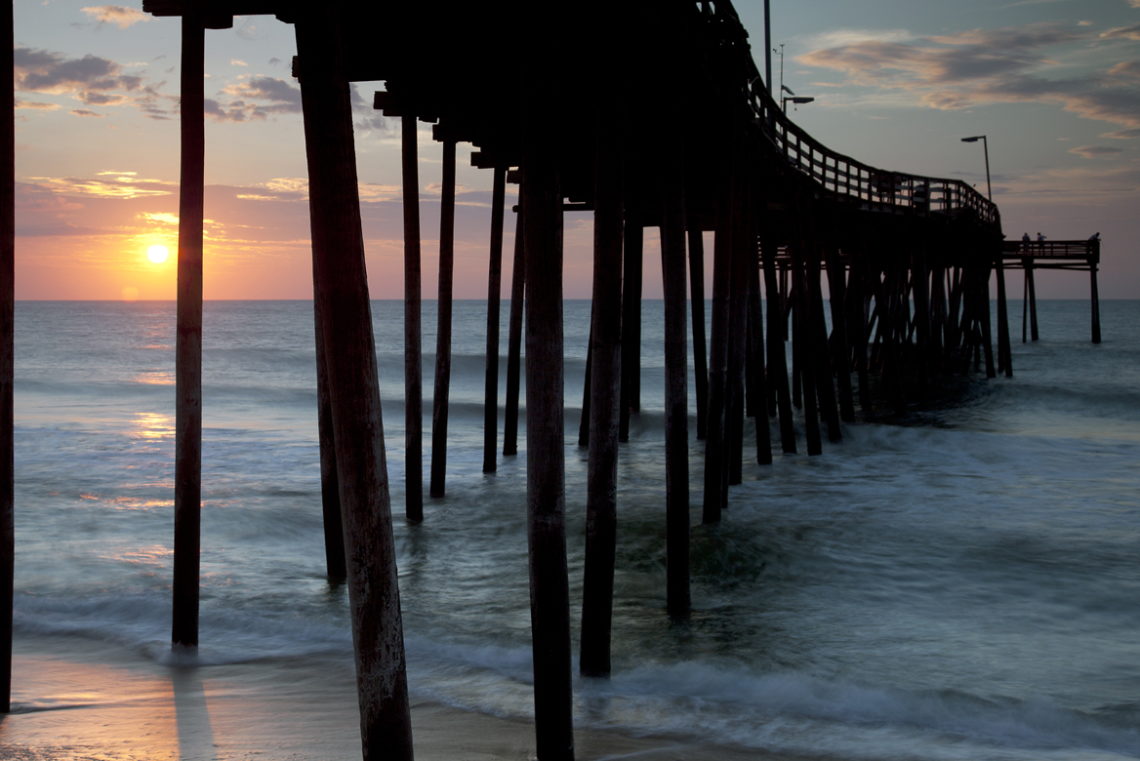
US Highway 17 neither begins nor ends in eastern North Carolina. Yet it is the thread that ties together many of the historical and natural wonders of the coastal region. This stretch of highway ties together Elizabeth City in the northeastern section of the state and Wilmington, nearly 300 miles to the south. The road has many names that are evocative of its role: the Ocean Highway and the Historic Albemarle Tour Highway to name a couple.
But then again, this road is many things. Just south of Vanceboro, for example, the highway cuts a straight line through marshy bottomland overgrown with cypress and pine, and moss-covered trees loom over the road. Suddenly, the highway veers to the right, the forest gives way, and the shining blue waters of the Neuse River appear-with the characteristic steeples and spires of New Bern huddled on the opposite shore.
Farther south, the traffic on Highway 17 meanders through the Wilmington Historic District, one of the best-preserved urban sections of Old South architecture in existence. Rambling Victorian, federal and Georgian homes line the shaded street. The highway then exits Wilmington via the Cape Fear River Bridge. And from this vantage point, travelers get a stunning glimpse of the city's restored waterfront.
Originally, Highway 17 was intended as the North Carolina segment of Interstate 95. But eastern Carolina politicians, appalled by the idea of an asphalt superhighway cutting through their farmlands, vetoed the idea, and the Interstate was diverted further west. Regardless, millions of people travel Highway 17 each year. The fact that it is not an interstate is a blessing since many of the gems along the route are fairly well kept secrets. All you need is a tank of gas, a road map, and a weekend to spare, and you can be on your way to discovering the charm and history of eastern Carolina via Highway 17.
From the north, 17 enters North Carolina from the Hampton Roads area. A few miles above the state line, the highway skirts the edges of the Great Dismal Swamp. Composed of more than 200,000 acres of brackish coastal swampland, the wilderness area is one of the only remaining untouched coastal swamps in the country. The swamp is home to a wide variety of plants and animals and is a designated National Wildlife Refuge.
Unfortunately, this environmental concern was not always the case. Up until 1976, land reclamation and drainage projects reduced the swamp from its original 800 square miles to its present size. Most of the swamp has been cut over at least once, and tangled underbrush and pine grow where thick stands of gum and cypress once stood.
Just south of the North Carolina line, the Dismal Swamp Canal Visitors Center is one of the most heavily trafficked visitor centers in the state-partially because it greets both motorists and boaters. The Dismal Swamp Canal, which runs behind the center, is part if the Intracoastal Waterway system. It is also one of the earliest man-made canals in the country, completed in 1805 as a link between the Chesapeake Bay and Albemarle Sound. For many years, it was the principal water trade route between the farms of northeastern North Carolina and the port of Norfolk. The canal has been placed on the National Register of Historic Places and designated a National Engineering Landmark.
A few miles south, Highway 17 runs through the heart of Elizabeth City. Founded in 1793, the town thrived on commerce generated by the canal. After the Civil War, the town fell into poverty and decay, like many of North Carolina's riverfront communities. But in the 1970s, city leaders began a revitalization of the waterfront, and now Elizabeth City is one of the prime overnight stops on the IntraCoastal Waterway, with thousands of boaters (including famed broadcaster Walter Cronkite) taking advantage of the town's amenities.
The town also boasts a self-guided walking tour through the Historic District. And just outside of town, the Museum of the Albemarle invites visitors to take a glimpse into the rich history of the ancient Albemarle Region.
From here, Highway 17 meanders along the north shore of the Albemarle Sound, touching several quaint historic riverside towns. Hertford is in the heart of the region, and many fine 19th century homes line Front Street. The nearby Newbold-White House is considered to be the oldest surviving brick structure in the state and is open to visitors.
Ten miles west of Hertford lies the jewel of the Albemarle, Historic Edenton. Located at the confluence of the Chowan River and Albemarle Sound, Edenton's restored colonial historic district is often compared to Williamsburg. Founded in 1722, the town served as the primary seaport of the colony. Pirates anchored in the sheltered harbor. Slaves were unloaded from the West Indies. And the first stirring of patriotism emerged here prior to the Revolution. In 1774, a group of Edenton ladies led by the wife of a British customs agent staged the southern version of the Boston Tea Party by boycotting East India Tea.
Today, the waterfront Barker House serves as the starting point for a wonderful tour of the State Historic Site. Over 25 homes and other buildings make up the tour, which is lead by costumed guides. For an added treat, take the Christmas tour.
Southwest of Edenton, Highway 17 continues on to Windsor, where historic Hope Plantation offers visitors a glimpse into rural life in colonial North Carolina. From there, the road turns due south, passes through Williamston, and enters Beaufort County, one of the oldest counties in the state. The county seat of Washington was the first town in the country to be named after the first president in 1776.
Another example of civic-minded restoration characterizes this beautiful riverfront town, which is situated where the Tar River broadens into the majestic Pamlico. Stewart Parkway is the centerpiece of the waterfront revitalization project begun in the 1970s. The Parkway winds along the river's edge and is the site of fireworks on the Fourth and a fantastic summertime festival.
Pick up a map at the nearby Visitor's Center and take an hour to experience the self-guided walking tour, which incorporates the town's oldest sections. On West Main Street, for example, Elmwood is a prime example of Federal architecture. Built in 1820, the huge private home served as a hospital during a series of Civil War battles. It was featured in Harper's Weekly at the start of the war. At St. Peter's Episcopal Church, the relatives of the town's most famous native, Cecil B. DeMille, are buried.
One side trip of note is the beautifully restored village of Bath, about 20 miles east of Washington. Founded in 1710, the town is state's oldest incorporated town and is now a State Historic Site. The shaded streets that were once walked by Blackbeard the pirate are now quiet, and visitors can leisurely tour the many restored homes and buildings, including St. Thomas Episcopal Church, the oldest continually operating church in the state.
Back on Highway 17, head south to New Bern, one of North Carolina's best-loved towns. The town is laid out on a peninsula formed by the juncture of the Trent and Neuse Rivers. It served both as a major seaport and colonial capitol. The royal governor constructed the magnificent Tryon Palace in 1770, and a thriving business district grew up in the center of the town. The town was occupied by Union forces during the Civil War. Today, the Palace has been rebuilt and restored, and is one of the state's top visitor attractions. A stunning historic district that can be explored either by car or on foot surrounds it.
From New Bern, Highway 17 continues south to Jacksonville, home of Camp LeJeune Marine Base. A quick side trip to Topsail Beach is worth while. Devastated by Hurricane Fran in 1996, the ocean resort community has rebounded nicely. Topsail Island was once owned by the military and was the site of many rocket tests after World War II. The remnants of the concrete lookout towers dot the beaches.
Along this stretch of Highway 17, travelers notice a distinct change in the landscape. The low swamps of the northeastern section of the region give way to open sandy savannas punctuated by pine hammocks and evergreen brush. The climate here is subtropical and noticeably warmer.
This is the gateway to the Cape Fear region, an area once coveted by South Carolina. In fact, it nearly became part of the Palmetto State until the colonial governor laid claim to the region in 1727 by building Brunswick Town on the banks of the Cape Fear River.
Twenty miles upstream from Brunswick Town, the thriving port of Wilmington is the cultural and economic center of the southeastern part of the state. This thriving city of 100,000 is a diverse community with an economic base that makes it one of the most desirable relocation destinations in the south. However, this wasn't always the case. During the Civil War, the port town had one role as the main port of entry for blockade runners that supplied Robert E. Lee's troops in Virginia. By 1864, the other major southern ports had fallen into Union hands. The city thrived until its capture by Union forces in 1865. Then, for nearly a hundred years afterwards, Wilmington languished.
In the 1970s, the city, like its sister communities in eastern North Carolina, began to revitalize itself. In 1974, a 20-block section of downtown was included on the National Register of Historic Places, and the Historic Wilmington Foundation was formed to buy and preserve other older structures. The decimated riverfront was renovated and now sports an eclectic collection of shops and restaurants.
Horse-drawn carriage rides and walking tours lead visitors through the historic district. Chandler's Wharf and The Cotton Exchange anchor the busy riverfront business section. Riverboats again ply the waters of the Cape Fear, this time offering dinner and sightseeing cruises.
Leisure activities abound in and around Wilmington. Wrightsville Beach, the oldest oceanfront resort in the state is 20 miles from the heart of downtown. The Intracoastal Waterway passes by here, and boaters from all over the world make a stop at Wilmington's riverfront. And golf here is legendary. Don't be surprised if you see a movie star or two as well. Dozens of movies and television series are filmed in and around Wilmington each year, thanks to the presence of Carelco Studios.
From Wilmington, Highway 17 parallels the coast to the South Carolina line. Several of North Carolina's oldest family beach resorts are just off the trail: Long Beach, Holden Beach, Ocean Isle Beach, and Sunset Beach. Just before the South Carolina line, Calabash is a must-stop for seafood lovers who appreciate the distinctive Calabash style.
A few miles north, intrepid nature lovers can explore the Green Swamp National Natural Landmark. Besides cougars, bears, otters, and alligators, the swamp is home to some interesting plant species, such as the carnivorous Venus Flytrap, Pitcher Plants, and Sundew. These plants thrive in the nutrient-poor sand due to their ability to trap and digest small insects.
It is here that Highway 17 exits eastern North Carolina, and it is fitting that the road is anchored on both ends by wild swampland. Geography has long been a curse and a blessing for this part of the state. A curse because it has impeded the type of development that has characterized coastal sections of the neighboring states of Virginia and South Carolina-and a blessing for the very same reason.




